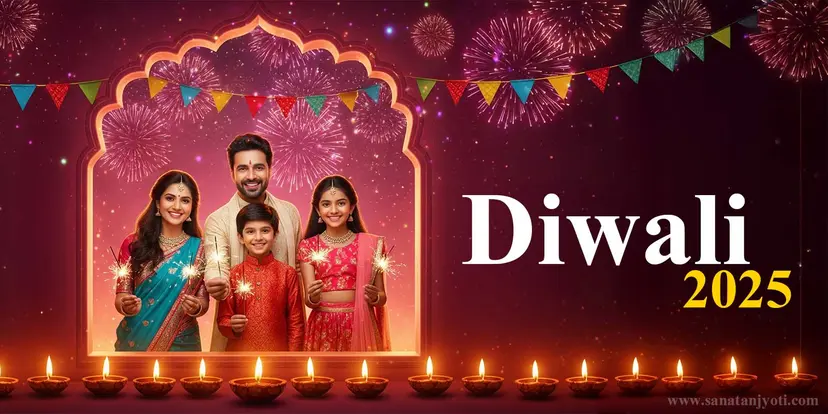Diwali (Deepawali) is celebrated on the new moon day (Amavasya) of the Krishna Paksha in the Kartik month. Diwali is a five-day-long festival. It begins with Dhanteras on the Trayodashi of Krishna Paksha, followed by Narak Chaturdashi on Chaturdashi, Diwali on Amavasya, Govardhan Puja or Annakut on Pratipada, and Bhai Dooj on Dwitiya. Thus, the Diwali festival continues for five days. On Diwali day, Goddess Lakshmi roams the Earth and fills the homes of her devotees with happiness and prosperity. Therefore, people worship Goddess Lakshmi, Lord Ganesha, and Lord Kuber with full devotion and faith.
In 2025, Diwali will be celebrated on 20th October. On this day, the auspicious time for Lakshmi Puja will be during the Pradosh Kaal from 6:52 PM to 8:48 PM. The Amavasya Tithi, which forms the basis of Diwali, will begin on 20th October 2025 at 3:47 PM and will continue until 21st October at 5:54 PM. Therefore, the Diwali festival in 2025 will formally begin on 20th October.
What is the Diwali Festival?
Diwali, also known as Badi Diwali, is celebrated on the Amavasya Tithi of Krishna Paksha in Kartik month. On this day, Goddess Lakshmi and Lord Ganesha are worshipped. It is said that on this day, Lord Shri Ram returned to Ayodhya with Mata Sita after defeating Ravana. The people of Ayodhya decorated the entire city and lit lamps to welcome Lord Ram. Hence, on this day, people decorate their homes and light lamps in celebration of Lord Ram’s return. On Diwali night, it is dark, but everyone tries to ensure that no corner of the house remains unlit—there is light all around. Darkness is considered a symbol of evil, while light is considered a symbol of goodness. Therefore, efforts should be made to keep every corner of the house illuminated.
It is believed that on Diwali, Goddess Lakshmi enters homes to bestow good fortune and prosperity. Therefore, one should consume only sattvic food on this day and avoid tamasic food. On this auspicious occasion of Diwali, gambling and alcohol consumption should be strictly avoided, as these anger Goddess Lakshmi.
What is Chhoti Diwali Festival?
The day before Diwali is celebrated as ‘Narak Chaturdashi’ or ‘Chhoti Diwali.’ Lighting a lamp on Narak Chaturdashi prevents untimely death. Lighting a mustard oil lamp near the entrance or drainage (where dirty water exits the house) invites the blessings of Lord Yama.
According to religious belief, on this day, Lord Krishna killed the demon Narakasura and freed around sixteen thousand one hundred Gopis from his captivity, thus liberating them from a hellish life. On this day, after sunset, a four-faced lamp is lit in the south direction, and prayers are offered to Lord Yama with folded hands. This practice is believed to free one from the fear of hell, brings mental peace, and removes restlessness.
Lust, anger, and greed are said to be the three gates to hell. Worshipping Lord Yama on this day frees a person from lust, anger, and greed. Special attention should be given to cleanliness on this day because Diwali is celebrated on Kartik Amavasya, and the arrival of Lakshmi should not be hindered by any form of impurity in the home.
Diwali 2025 Date and Time
Date of Diwali Festival: 20th October 2025
For Business Establishments:
- On 20th October 2025, in Aquarius Lagna from 2:14 PM to 3:43 PM, and in Vrishabha (Taurus) Lagna from 6:52 PM to 8:48 PM
- On 21st October 2025, in Aquarius Lagna from 2:16 PM to 3:45 PM
Auspicious Muhurat for Lakshmi Puja: During Pradosh Kaal in Vrishabha Lagna, from 6:52 PM to 8:48 PM
For Tantrik Puja & Mantra Siddhi: In Singh (Leo) Lagna, during the night from 1:11 AM to 3:33 AM
Amavasya Start Date: From 3:47 PM on 20th October 2025
Amavasya End Date: Till 5:54 PM on 21st October 2025
Note: On 21st October 2025, Amavasya for holy bath and donation will be observed.
Story of Diwali
There are many mythological stories about the Diwali festival. One such story says that after 14 years of exile, Lord Shri Ram, Mata Sita, and Lakshman returned to Ayodhya. The people of Ayodhya celebrated Diwali by lighting ghee lamps throughout the city to welcome their beloved king. Hence, Diwali is also known as the festival of Lord Ram’s return to Ayodhya.
According to another legend, on Diwali night, Goddess Lakshmi emerged from the ocean during the churning of the sea. Goddess Lakshmi is considered the goddess of wealth and prosperity, and thus, she is worshipped on this day.
Diwali Rituals and Traditions
Many traditional customs are observed during Diwali, which create an auspicious atmosphere. Some of the main rituals include:
- Cleaning and Decoration: Homes, shops, and temples are thoroughly cleaned days before Diwali. Walls are decorated with rangoli, and doorways are adorned with flowers.
- Lighting of Lamps: In the evening, lamps filled with ghee are lit in the courtyard and house. Diwali is called the festival of lights, so homes shine brightly throughout the night.
- Sweets and Gifts: People share sweets and gifts with relatives and friends, spreading joy. It strengthens love and harmony within the family.
- Lakshmi-Ganesh Worship: On Diwali evening, the head of the household performs the worship of Goddess Lakshmi and Lord Ganesha. Offerings include rice, flowers, fruits, coconut, and Panchamrit, with prayers for happiness and prosperity.
Benefits of Diwali
Diwali brings several spiritual, social, and economic benefits. Spiritually, it symbolizes the victory of light (knowledge) over darkness (ignorance). Socially, it enhances familial unity and love when everyone celebrates together. According to religious belief, worshipping deities on this day provides psychological peace and positive energy. Economically, Diwali is significant as people purchase new clothes, jewelry, and lamps, boosting trade and economic activity.
Diwali Puja Vidhi
On the Amavasya of Krishna Paksha in Kartik month, after taking a bath in the evening, the puja is begun. First, purify the puja space with Gangajal. Place a red cloth on a chowki (wooden platform) and put some unbroken rice (Akshat) on it, then place the idols of Ganesh Ji and Lakshmi Ji. In some places, a Kalash is established. For this, fill a pot with Gangajal, add a turmeric stick, a coin, a betel nut, and Durva grass. Place a bowl filled with rice on top, cover the Kalash with mango leaves, and place a coconut wrapped in red thread with a swastika on top. The Kalash should be placed on the right side of the chowki over some rice.
Bathe the idols of Ganesh and Lakshmi with Panchamrit and Gangajal. Apply tilak with roli, show incense, and offer garlands. Then offer fruits, sweets, flowers, and Naivedya to the deities. Listen to the story of Lakshmi and Ganesh’s significance. After completing the puja, light mustard oil lamps with cotton wicks and place them at the main door, in the temple, river, garden, and other places. On this day, decorate the cow with colors, feed her grass and grains, and perform circumambulation and worship.
Significance of Worshipping Ganesh and Lakshmi
On Diwali, Lord Ganesh and Goddess Lakshmi are worshipped with complete rituals. Maa Lakshmi is the goddess of wealth and fortune and worshipping her on Diwali not only brings material prosperity but also fills the home with happiness. Ganesh Ji is always worshipped first, so he is worshipped alongside Maa Lakshmi.
People decorate their homes according to their means. Maa Lakshmi only enters homes that are clean. Therefore, special attention is given to cleanliness. Worship on this day brings immense wealth to the home. Maa Lakshmi loves rangoli, so one should make rangoli at the entrance.
In Sanatan Dharma, the mango tree is considered divine, and its wood and leaves are used in all religious rituals. On Diwali, hang torans made of marigold flowers and mango leaves at the main entrance and temple door. This not only has religious significance but also attracts positive energy according to Vastu. Additionally, perform the puja properly according to tradition.
Diwali Mantra Chanting
Several significant mantras of Ganesh and Lakshmi are chanted on Diwali, such as:
- “Om Shreem Gam Saumyaya Ganapataye Vara Varada Sarvajanam Me Vashamanaya Swaha॥” – This is a Chaturdashi-Vishnu mantra of Ganesh Ji, considered auspicious for chanting.
- “Om Ganesh Rinam Chhindhi Varenyam Hum Namah Phat॥” – This is a Rinhara (debt-removing) Ganesh mantra, chanted for prosperity and obstacle removal in the household.
Chanting these mantras brings the blessings of Maa Lakshmi and removes obstacles. Additionally, traditional seed mantras of Lakshmi such as “Om Hreem Shreem Lakshmyai Namah” are also chanted.
Importance of Diwali
The Diwali festival holds immense significance from many perspectives. Religiously, it marks the return of Lord Shri Ram to Ayodhya and the emergence of Goddess Lakshmi. Spiritually, it symbolizes the victory of good over evil and knowledge over ignorance. Socially, it brings families together and increases social bonding. Economically, it boosts people’s interest in shopping and investment, encouraging trade and industry. Diwali is said to be a combination of five major festivals (Dhanteras, Narak Chaturdashi, Diwali, Govardhan Puja/Annakut, Bhai Dooj), which bestow wealth, dharma, desire, liberation, and welfare.
Specialty of Diwali
The specialty of Diwali is that it is celebrated for five days, and each day has its own significance. Starting from Dhanteras to Narak Chaturdashi (Chhoti Diwali), main Diwali, Govardhan Puja (Annakut), and Bhai Dooj, this festival is full of colors and joy. On Diwali, homes and courtyards are lit with lamps, and preparations begin early in the morning. Special sweets are shared among family and friends. Fireworks add to the festive atmosphere. In many regions, fasting and charity are also customary on this day.
Frequently Asked Questions
1. In which state is Diwali celebrated?
Diwali is celebrated with great enthusiasm in almost all states of India. Especially in Uttar Pradesh (particularly Ayodhya and Prayagraj), Rajasthan, Gujarat, Maharashtra, West Bengal, Punjab, Bihar, and Chhattisgarh, this festival is observed with exceptional excitement. Traditions may vary slightly across states, but lighting lamps and worshipping Lakshmi is common everywhere.
2. Why do we celebrate Diwali?
According to Hindu tradition, it is believed that on Diwali, Lord Shri Ram returned to Ayodhya after 14 years of exile and defeating Ravana. He was welcomed with water, rice, and by lighting lamps. Therefore, it is also called the festival of Shri Ram’s victory.
It is also believed that on this very night, Goddess Lakshmi manifested during the churning of the ocean (Samudra Manthan), hence she is worshipped. Thus, Diwali is celebrated as the triumph of good over evil and knowledge over ignorance.
3. What should we do on Diwali?
On Diwali, the house should be thoroughly cleaned, and rangoli should be made. Light lamps in the evening, decorate the home, and worship Goddess Lakshmi and Lord Ganesha. Distribute sweets and gifts among family and friends. Wear new clothes, participate in puja, and maintain a spirit of cooperation in society. Performing virtuous acts like charity and offering respect to elders brings merit.
4. How to celebrate Diwali at home?
To celebrate Diwali at home, first clean the entire house thoroughly. Decorate doors with rangoli or flowers and light lamps. Bathe with purity during the day and wear clean clothes. In the evening, perform Lakshmi-Ganesh Puja and share sweets and dishes with all family members. Maintain silence and exchange good wishes. Decorate the walls with earthen lamps and footprints of Goddess Lakshmi to create a festive atmosphere.
5. How to perform Diwali Puja?
Diwali Puja is mainly done in the evening. Begin the puja with Lord Ganesh’s worship, as no Lakshmi Puja is considered complete without invoking him first. Decorate the puja platform with a red cloth and place Akshat, flowers, turmeric, and coconut. Install the idols or pictures of Ganesh-Lakshmi. Sprinkle Gangajal with a lamp and arrange the puja items (lamps, camphor, incense, Naivedya). Chant Ganesh-Vishnu mantras and Lakshmi stotras. Finally, perform the aarti and pray for family unity and prosperity in the coming year. It is also auspicious for the whole family to sit together and partake in the prasad.
6. When will Diwali begin in 2025?
Date of Diwali Festival- 20 October 2025
Auspicious time for Lakshmi Puja- From 6:52 PM to 8:48 PM during Pradosh Kaal
Business Establishment Puja- Kumbh Lagna2:14 PM to 3:43 PM
Start of Amavasya Tithi- 20 October 2025 at 3:47 PM
End of Amavasya Tithi- 21 October 2025 at 5:54 PM
7. What should not be done on Diwali?
Keep yourself pure on Diwali. Avoid sleeping late, cutting nails, getting haircuts, and engaging in quarrels. Show respect to parents and elders. Do not entertain thoughts of hatred or malice during worship. Use candles or fragrant oils appropriately during offerings. Stay away from alcohol and tobacco. It is believed that Goddess Lakshmi roams during the evening, so avoid unnecessary noise in the dark. Following these practices keeps the goddess pleased and ensures peace and happiness in the home.
8. What should be done on the day of Diwali?
Wake up early, take a bath, and wear clean new clothes. Be inclined toward positive and auspicious activities all day. Light lamps on time in the evening. Participate in Lakshmi-Ganesh Puja to absorb positive energy. Spend time in devotional singing or storytelling. Light more lamps at night with family and exchange greetings. Giving charity on this day helps increase generosity. Overall, prioritize activities that promote happiness, prosperity, and harmony.
9. Why is it called Diwali?
The word ‘Diwali’ comes from two Sanskrit words – ‘Deep’ (lamp) and ‘Aavali’ (row). It means a row of lamps. The tradition is to light millions of lamps in homes on this day, place them at doors and windows, forming a series of lights. Hence, this festival is called Diwali or Deepavali.
Source URL:
https://www.sanatanjyoti.com/articles/diwali-2025-51





